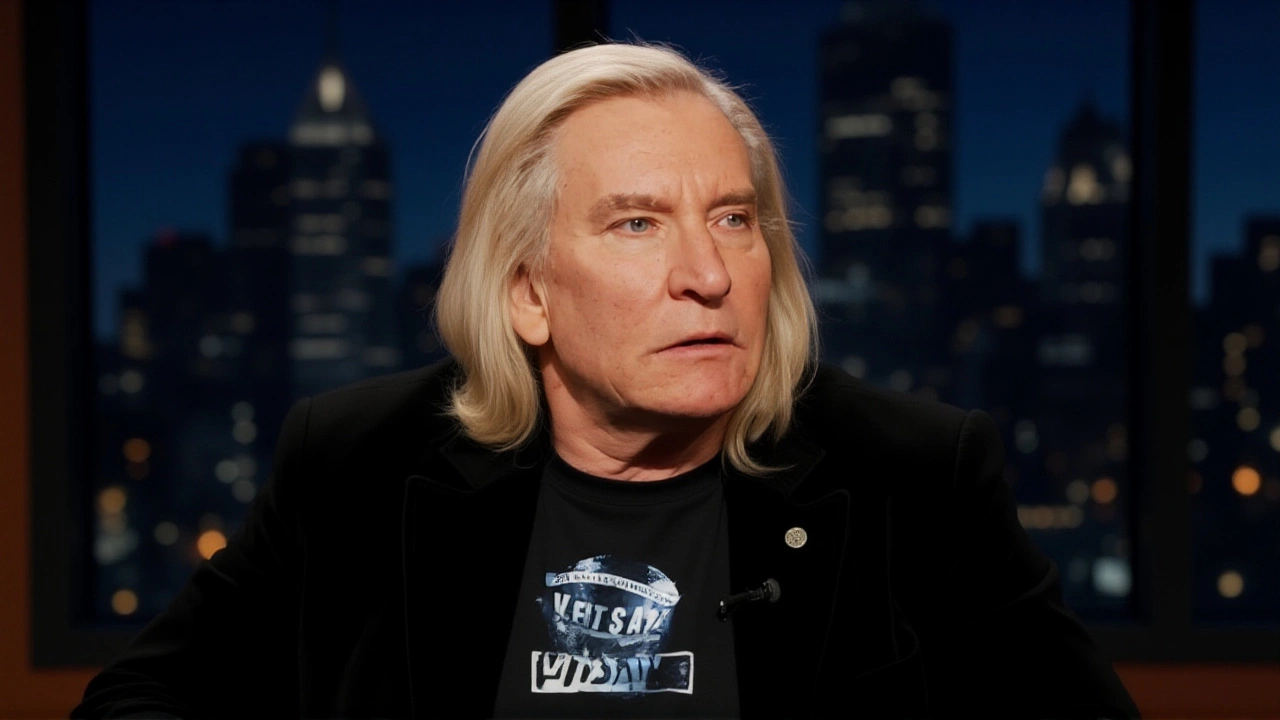Joe Walsh Turned Addiction and Recovery Into a Perfect Song: 'A Chance to Tell My Story'

When Joe Walsh sat down in 2012 to record his first solo album in two decades, he didn’t set out to make another rock anthem. He wanted to tell the truth. The 77-year-old guitarist, best known for his searing solos with the Eagles and his earlier work with the James Gang, quietly released Analog Man on March 12, 2012, through Mailboat Records and Rhino Entertainment. And at its heart was a song that wasn’t just music—it was a confession.
A Song That Wasn’t Supposed to Be a Hit
The track was called "One Day at a Time." Not a chart-topper, not even a single. But for Walsh, it was the most important thing he’d written in years. In a 2012 interview with Classic Rock Revisited, conducted by journalist Jeb Wright, Walsh didn’t mince words: "I just wanted a chance to tell my story. I just wanted to tell what it was like and what it is like now, and not embellish anything." He wasn’t talking about fame, or guitars, or touring. He was talking about addiction. About the years lost, the relationships fractured, the quiet mornings after the binges. "It can be a real challenge for a songwriter to get to the essence of the topic without padding it with all of the recovery slogans that we say," he added. "But I think I did it on this song." The phrase "a chance to tell my story" has since been misquoted as a song title—appearing in headlines as if it were the name of a track. But it wasn’t. It was the intention behind the song. And that distinction matters. Because in an era where recovery narratives are often sanitized, Walsh’s lyrics were raw, unvarnished, and startlingly honest.The Sequel to ‘Life’s Been Good’
Walsh didn’t stop at one personal revelation. On the same album, he co-wrote "Lucky That Way" with Nashville songwriter Tommy Lee James, whom he met through a recommendation from Barbara Orbison, widow of the legendary Roy Orbison. "Tommy brought out the chorus," Walsh explained. "I was coming out to write with him, so I had to bring something, so I wrote the verses." The result? A bittersweet reflection on aging, resilience, and gratitude—a natural follow-up to his 1978 smash "Life’s Been Good." Where that song was a satirical anthem of rock excess, "Lucky That Way" is a quiet nod to survival. "It’s sort of the sequel," Walsh said with a chuckle. "I’m not rich, I’m not famous anymore, but I’m still here. And that’s lucky." The song’s Nashville thread didn’t make it sound country—it made it feel real. There’s no pedal steel, no fiddle. Just Walsh’s voice, his guitar, and a truth that doesn’t need embellishment.Reinventing the Past, One Sample at a Time
Analog Man wasn’t just about looking inward—it was about reaching back into the past and pulling out forgotten sounds. After witnessing a live performance in India, Walsh became obsessed with a particular electronic texture he’d never heard before. "I came back home and said, ‘I don’t know how, but I’m going to do one of those.’" He dug into his computer, layered samples, and built a new sonic palette from scratch. Then he handed it to Bob Heil, the legendary audio engineer who’d helped craft his iconic 1970s tone. "He can manufacture stuff," Walsh said. "He took it from there and started making new ones." The result? A track that married vintage analog warmth with digital experimentation. Walsh called it a reinvention—not just of sound, but of himself. "I brought it out of retirement from the ‘50s," he noted, referencing the first time he’d used that particular effect: on his 1972 hit "Rocky Mountain Way."
Why This Matters Now
On October 19, 2025, Far Out Magazine staff writer Tim Coffman published an article titled "Joe Walsh told his entire life story within one perfect song: 'A chance to tell my story'"—a phrase that had been floating in music journalism since at least 1999, when it appeared in Radio & Records as a broader commentary on artist authenticity. But in Walsh’s case, it wasn’t poetic license. It was autobiography. His career spans over 50 years—from the psychedelic blues of the James Gang, to the polished country-rock of the Eagles, to the introspective twilight of Analog Man. And through it all, music has been his diary. "Been good for him so far," Coffman wrote. And it’s true. Walsh didn’t just survive addiction—he turned it into art that helped others feel less alone. He didn’t just play guitar—he used it to say what words alone couldn’t.What’s Next for Joe Walsh?
At 77, Walsh still tours with the Eagles, though he’s said he’s "not chasing the spotlight anymore." He’s been working on new material—mostly acoustic, mostly quiet. No grand announcements. No comeback tours. Just songs. He told Classic Rock Revisited he’s "writing for the people who still remember the old ones, and the ones who haven’t heard them yet." He doesn’t need to prove anything. His legacy isn’t in the charts. It’s in the silence after a song ends—when someone hears "One Day at a Time" and realizes they’re not the only one who’s been there.Frequently Asked Questions
Is 'A Chance to Tell My Story' an actual Joe Walsh song title?
No, it’s not a song title—it’s a direct quote from Walsh’s 2012 interview about his song "One Day at a Time." The phrase has been misquoted in media since at least 1999, but Walsh never named a song that. He used the phrase to describe his intent: to write honestly about his addiction and recovery without clichés.
How did Joe Walsh’s personal struggles influence his music?
Walsh’s battles with alcohol and drug addiction shaped his most authentic work, especially on the 2012 album Analog Man. "One Day at a Time" is a rare, unfiltered look at recovery without the usual self-help language. His 1978 hit "Life’s Been Good" mocked rock excess; decades later, "Lucky That Way" quietly celebrated survival. His music became his therapy—and his testimony.
Who is Tommy Lee James, and how did he help Walsh?
Tommy Lee James is a Nashville-based songwriter and producer recommended to Walsh by Barbara Orbison, widow of Roy Orbison. James co-wrote "Lucky That Way," crafting the chorus while Walsh wrote the verses. Their collaboration blended country storytelling with Walsh’s rock sensibility, resulting in a song that felt both grounded and deeply personal.
Why was Bob Heil important to the making of Analog Man?
Bob Heil, a pioneering audio engineer who worked with Walsh since the 1970s, helped develop the unique electronic textures on Analog Man. After Walsh was inspired by a sound he heard in India, he created a demo and brought it to Heil, who then built custom analog-digital hybrids. Heil’s expertise turned Walsh’s experimental ideas into playable, studio-ready sounds.
What’s the significance of the Analog Man album title?
The title reflects Walsh’s rejection of digital perfection in favor of human imperfection. After decades of chasing the latest tech, he returned to analog gear and raw, unedited performances. The album is a metaphor: he’s not trying to be modern—he’s choosing to be real. "I’m an analog man in a digital world," he said. And in 2012, that felt like a quiet revolution.
How has Joe Walsh’s legacy evolved since joining the Eagles?
Though he gained fame with the Eagles in 1975, Walsh’s solo work—especially Analog Man—has redefined his legacy. He’s no longer just the guitarist with the wild solos; he’s the songwriter who turned pain into poetry. His career now spans three generations of fans: those who grew up with "Rocky Mountain Way," those who discovered him through the Eagles, and now, those who find hope in "One Day at a Time."

